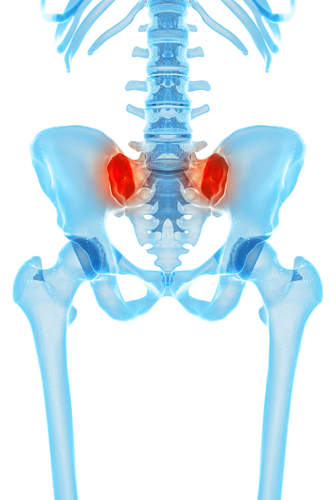 The sacroiliac (SI) joint can be a source of back pain for many patients. The joint is composed of the sacrum (bottom portion of the spine) and the iliac crest (part of your pelvis). The joint does not have a broad range of motion like other joints in the body. It does, however, use its limited motion to act as a shock absorber for stresses moving from your back to your pelvis.
The sacroiliac (SI) joint can be a source of back pain for many patients. The joint is composed of the sacrum (bottom portion of the spine) and the iliac crest (part of your pelvis). The joint does not have a broad range of motion like other joints in the body. It does, however, use its limited motion to act as a shock absorber for stresses moving from your back to your pelvis.
It is believed that pain is most often caused by either increased motion or increased stress through the joint. This typically presents as low back pain localized to one or both sides. It can also cause pain into the buttock or even mimic “sciatic” pain shooting down the back of the leg. It often hurts to sit or stand for long periods with weight shifted to the affected side, and sleeping on the involved side can be painful as well.
A spine specialist can do a physical exam to help determine if your pain is coming from the SI joint. Many times x-rays are obtained. It is important to rule out other possible causes of pain; this often means ordering an MRI of the lumbar spine to rule out a herniated or degenerating discs as the problem, as the symptoms are similar. An injection of local anesthetic (as one might get at the dentist) into the sacroiliac joint can be helpful identifying the joint as the source of pain.
 If it is determined that the SI joint is causing pain, there are several treatments your doctor might recommend to try. Ice and anti-inflammatories are often a first line of treatment. Sometimes physical therapy exercises are beneficial, as is a brace to help support the area.
If it is determined that the SI joint is causing pain, there are several treatments your doctor might recommend to try. Ice and anti-inflammatories are often a first line of treatment. Sometimes physical therapy exercises are beneficial, as is a brace to help support the area.
Many times, an SI injection might be tried. Usually with visual assistance such as x-ray or ultrasound, a small needle is guided into the joint and a combination of steroid and numbing medicine is injected into the joint. The steroid can calm down inflammation to help decrease pain. For patients who are intolerant of steroids or for whom steroids have failed to provide relief, radiofrequency ablation (destruction) of the sensory/pain fiber nerves can decrease pain.
If all conservative options have failed to provide extended relief, and there is a high degree of certainty that the joint is causing the pain, a surgeon may recommend an SI fusion. This involves a small incision through which a spine surgeon places stabilizers (there are different kinds) across the joint to stop any extra motion. This helps to decrease inflammation and therefore pain.
It is important to discuss your symptoms with a spine doctor and together create a treatment plan. Knowledge about SI joint pain has become more widespread, and with this so have treatment options.
This article originally posted on KnowYourBack.Wordpress.com.
 Rachel J. Cengia, PA-C, ATC
Rachel J. Cengia, PA-C, ATC
Rachel is a Physician Assistant at the Center for Spine & Orthopedics. She is also a certified Athletic Trainer. She has worked in Podiatry and also has experience in sports medicine. Rachel is a licensed Physician Assistant in the state of Colorado. She received her Master’s Degree in Biomedical Sciences at the University of Toledo. Rachel is actively involved in the care of the spine patient, collaborating with our spine surgeons to provide the patient with the best possible care.








